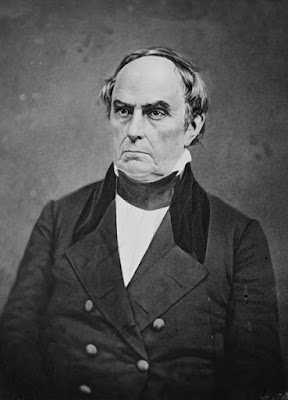March 7, 1850: Senator Daniel Webster gives his "Seventh of March" speech
 With the conclusion of Mexican-American War, the debate over slavery was reignited. Since the nation's inception, the issue of slavery threatened to destroy the unity of the nascent republic. The Founders were forced to table the issue in order to bring the fledgling states into unison. As the founding generation faded into history, the issue reared its head as new states attempted to join the original thirteen. By the turn of the 19th century, the northern states had almost entirely abolished slavery. Slavery mostly remained in southern states due to economic facility and cultural norms. In 1820, the question of over slavery reached a boiling point.
With the conclusion of Mexican-American War, the debate over slavery was reignited. Since the nation's inception, the issue of slavery threatened to destroy the unity of the nascent republic. The Founders were forced to table the issue in order to bring the fledgling states into unison. As the founding generation faded into history, the issue reared its head as new states attempted to join the original thirteen. By the turn of the 19th century, the northern states had almost entirely abolished slavery. Slavery mostly remained in southern states due to economic facility and cultural norms. In 1820, the question of over slavery reached a boiling point.When Missouri applied for statehood in 1820, it threw the delicate balance free and slave states into flux. Threats of secession rang out throughout the chambers of Congress. A compromise was needed in order restore the delicate balance. Representative Henry Clay of Kentucky proposed such a compromise. His Missouri Compromise allowed for Missouri territory to enter as a slave state and Maine (then a territory of Massachusetts) to enter as a free state. This would even out the number of free and slave states. The Compromise also created a line at the parallel 36 30 north, in which newly admitted territories that were admitted above the line would be free states and below would be slave states. After a prolonged stalemate, the Compromise was finally passed with the help of Representative Daniel Webster. The Missouri Compromise was controversial, but would stay in place for thirty years.
In 1848, the Mexican Cession entered the Union after the ratification of the Treaty of Guadalupe Hidalgo. The question of how to deal with the Cession sparked a whole new debate on slavery. Two familiar figures emerged to solve the crisis. Now Senators, Henry Clay and Daniel Webster took up the challenge to peacefully resolve the conflict. On a warm, Spring night in 1849, Clay and Webster hammer out a compromise over glasses of bourbon. This story is probably apocryphal. The compromise was most likely discussed and debated in the halls of Congress throughout 1849. By the end of the year, a deal was in sight. The Compromise of 1850 had five major stipulations. Firstly, California would be admitted as a free state. Secondly, New Mexico and Utah would be formed into two distinct territories. Thirdly, the Texas border with Mexico would be firmly established. Fourthly, a stronger fugitive slave law would be enacted. Lastly, the purchase of slaves would be disallowed in the District of Columbia. The Compromise, which seemingly appealed to both North and South, was largely unwelcome by both. Clay rallied his allies to defend the proposal he worked so hard to forge. On March 7, Webster rose to the Compromise's defense. In a short oration, he affirmed that the Compromise was necessary to preserving the Union, regardless of how distasteful the some of tenets were to both parties. The legislators remained somewhat skeptical but were largely convinced by Webster's passionate defense. Congress would approve the Compromise in September. The Compromise of 1850 proved to be a stop-gap to civil war until the Supreme Court nullified the agreement in 1854.




Comments
Post a Comment